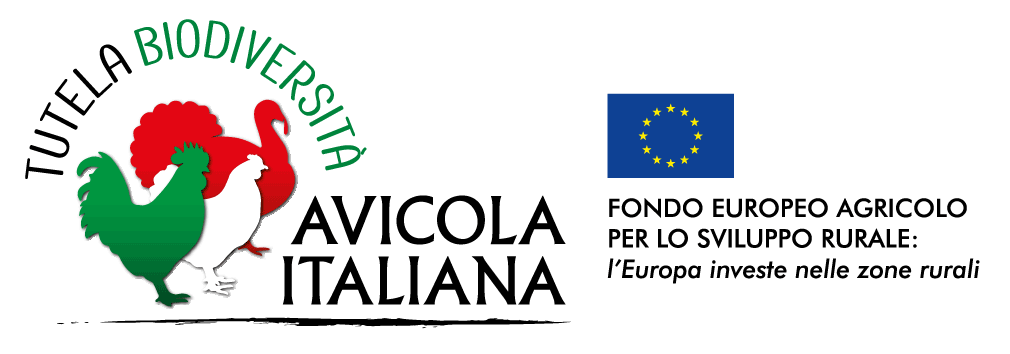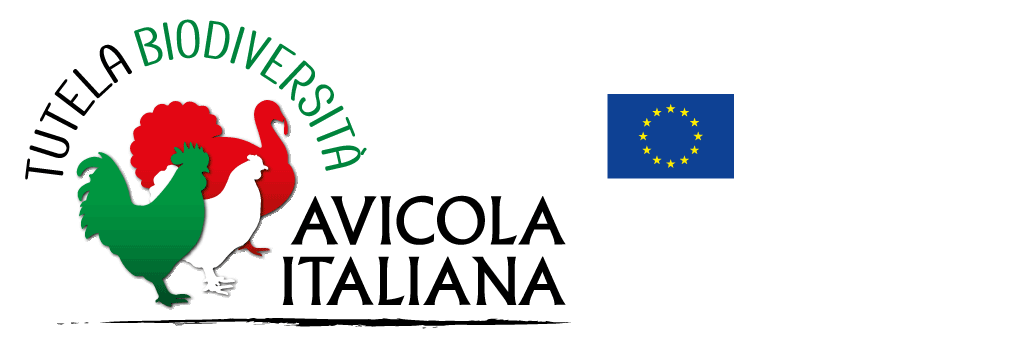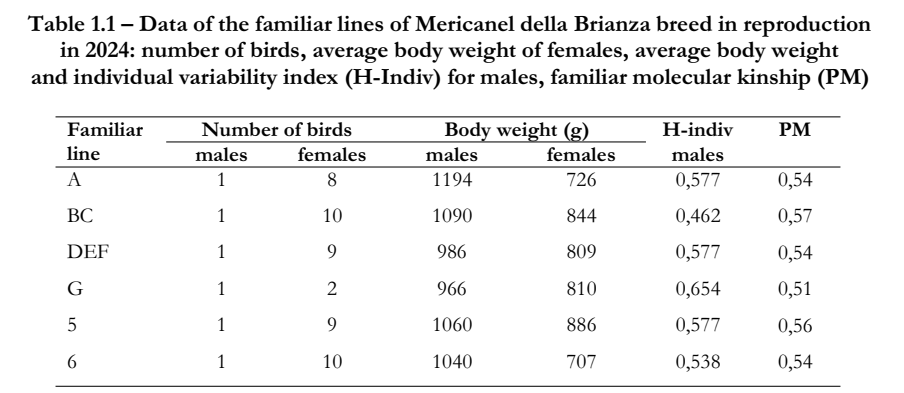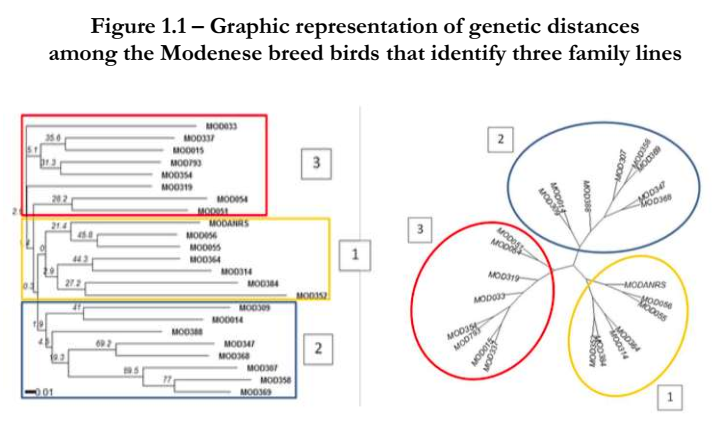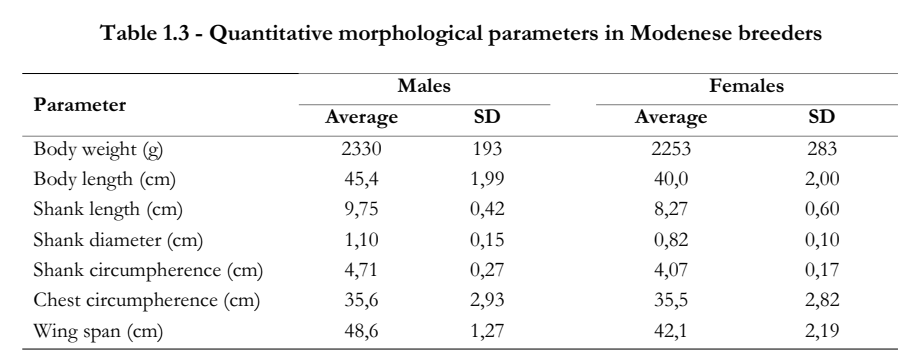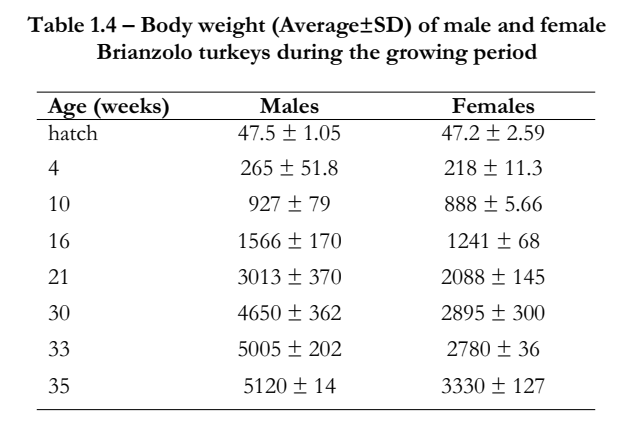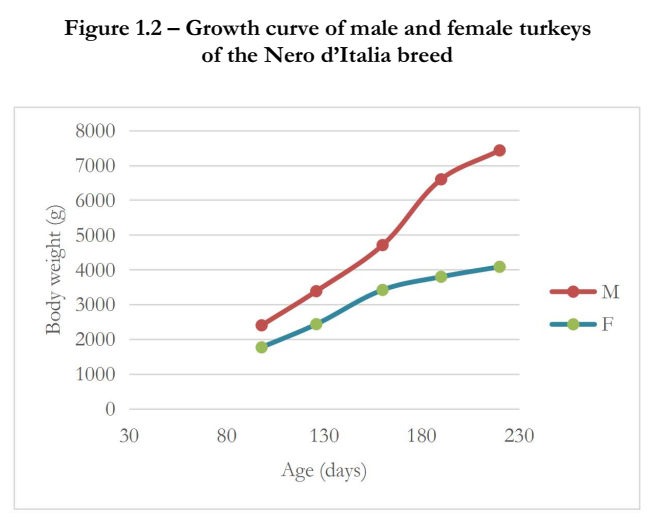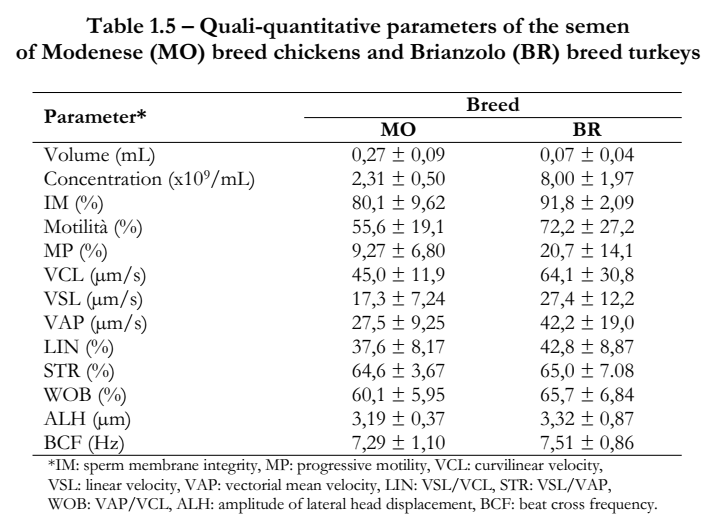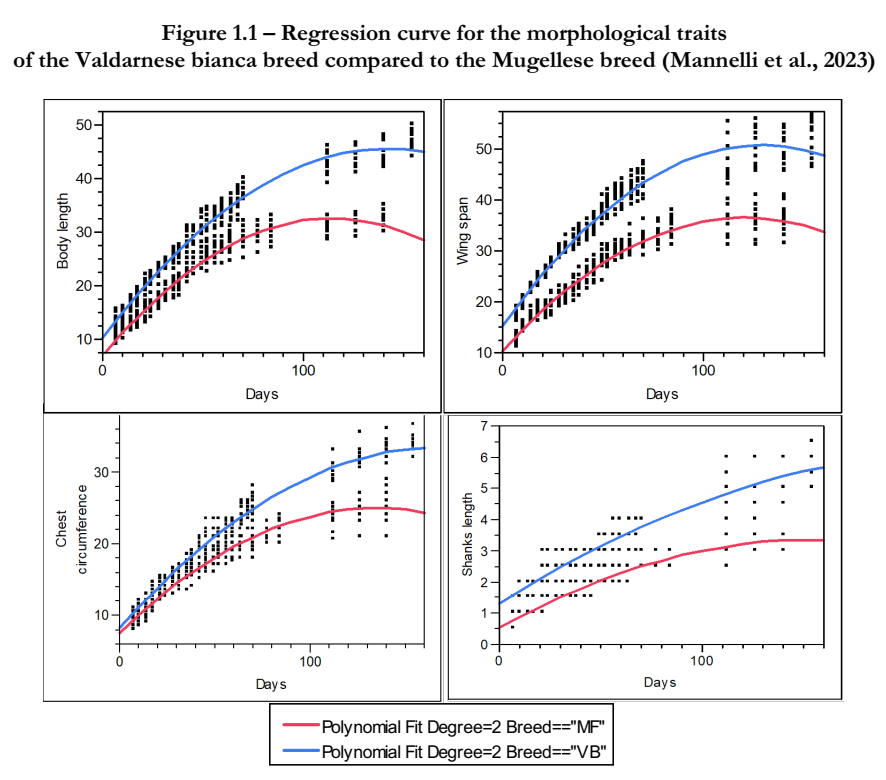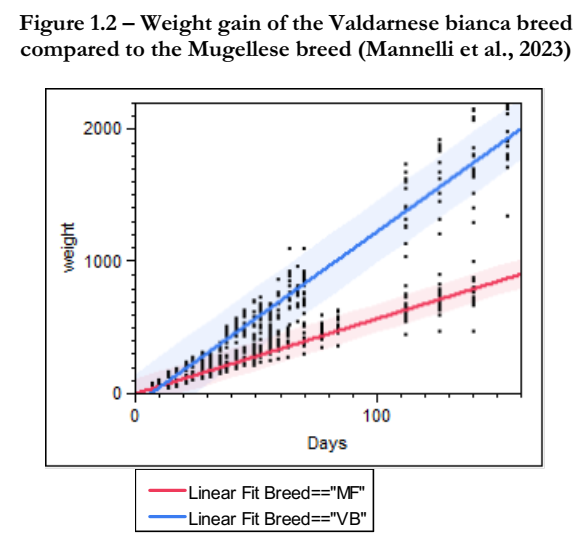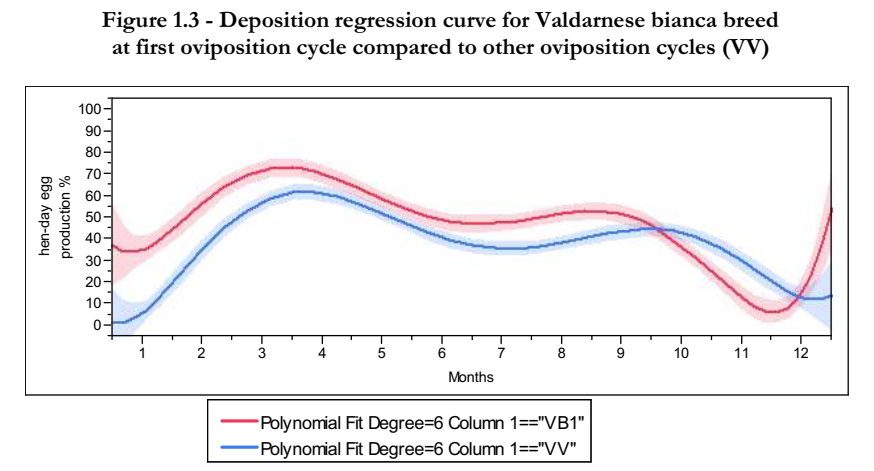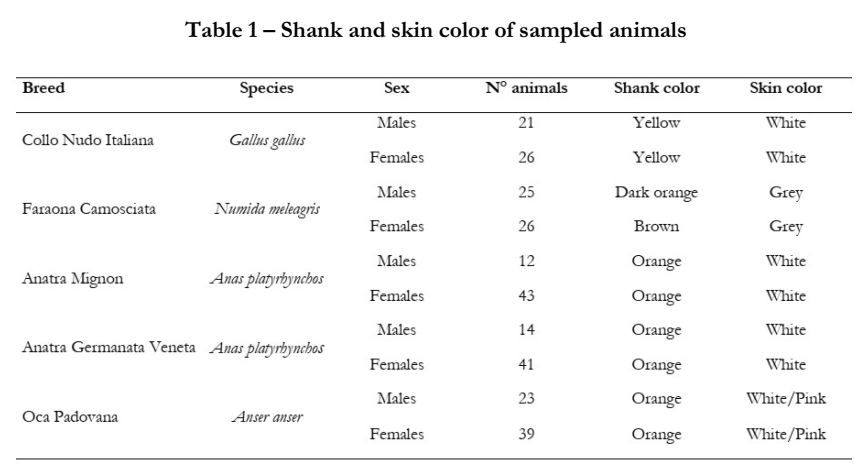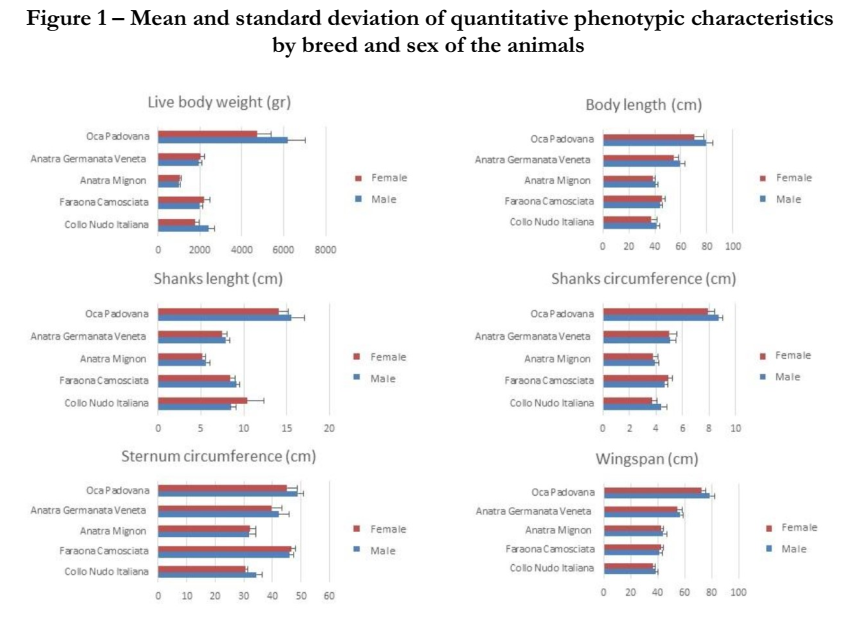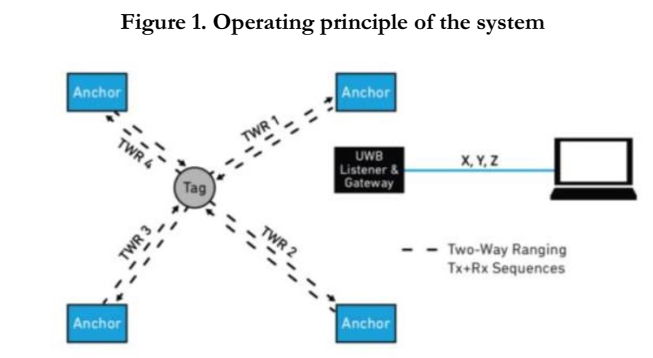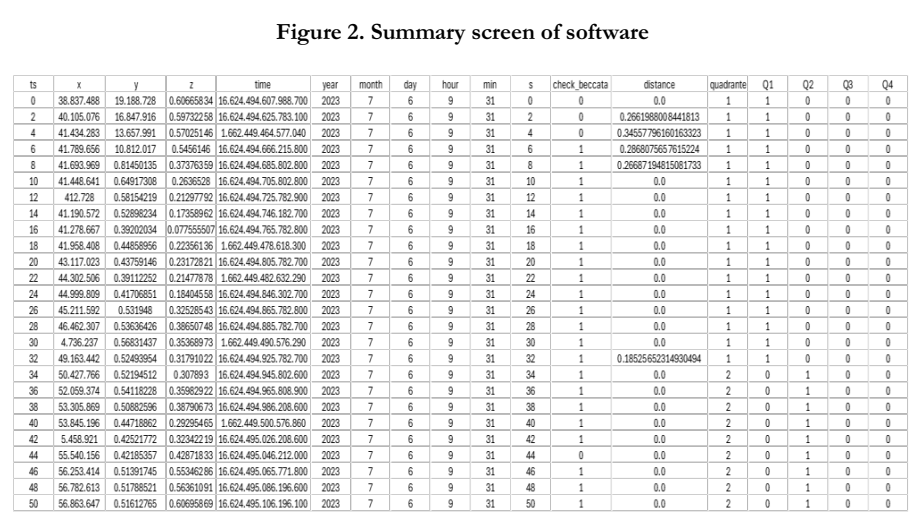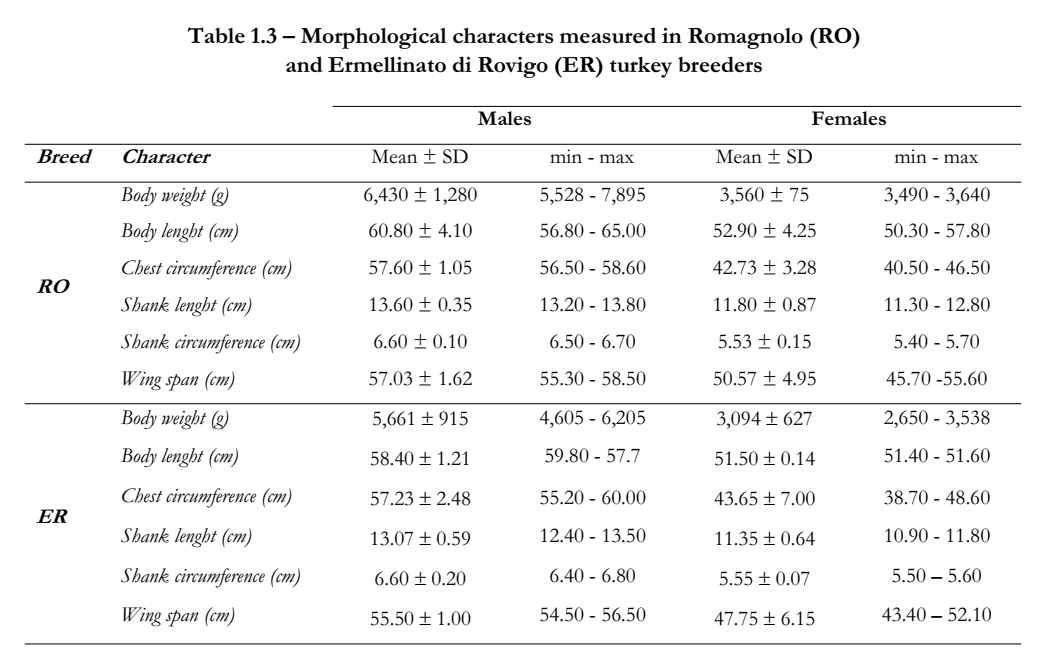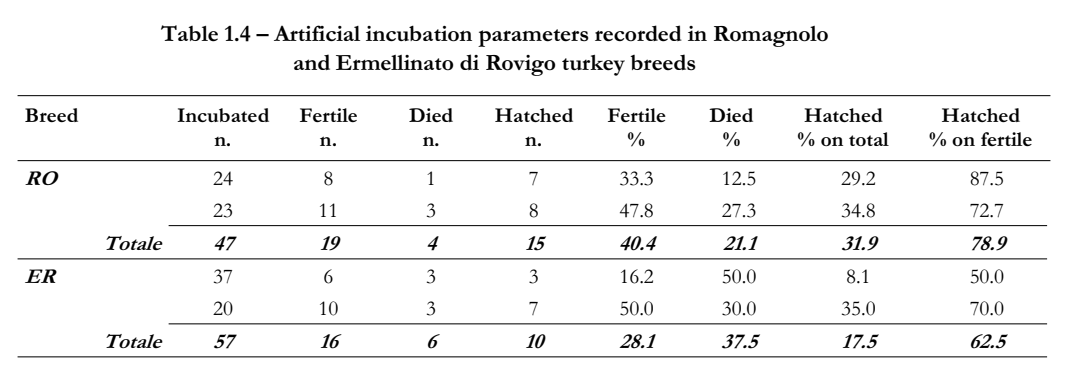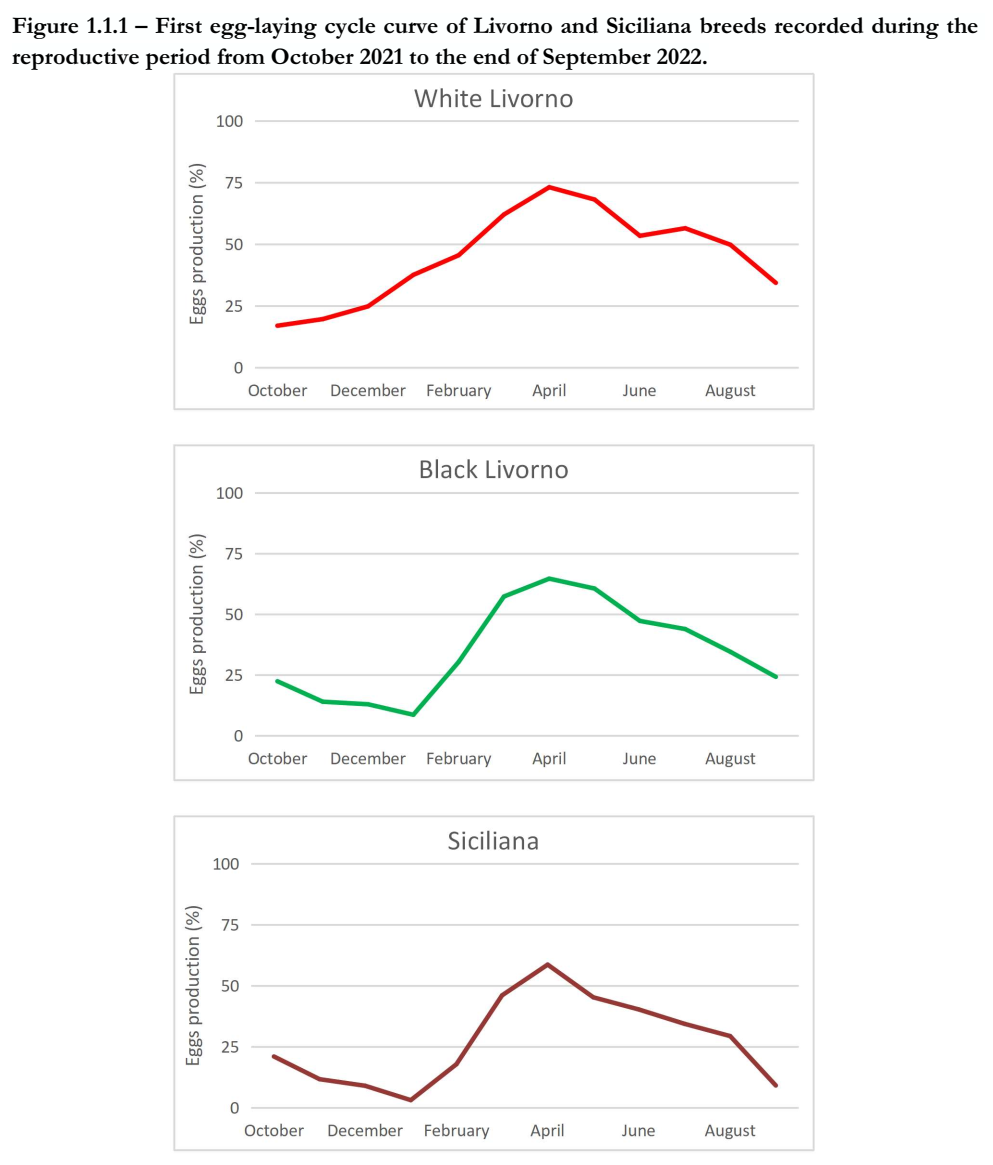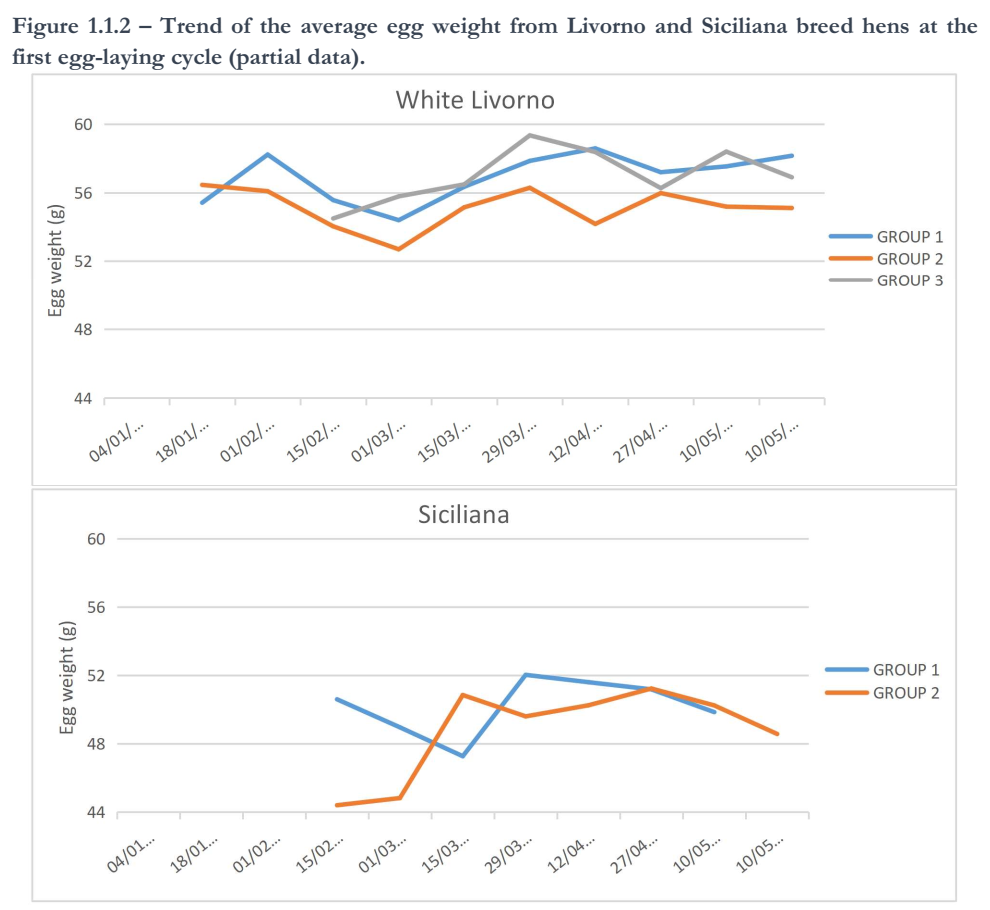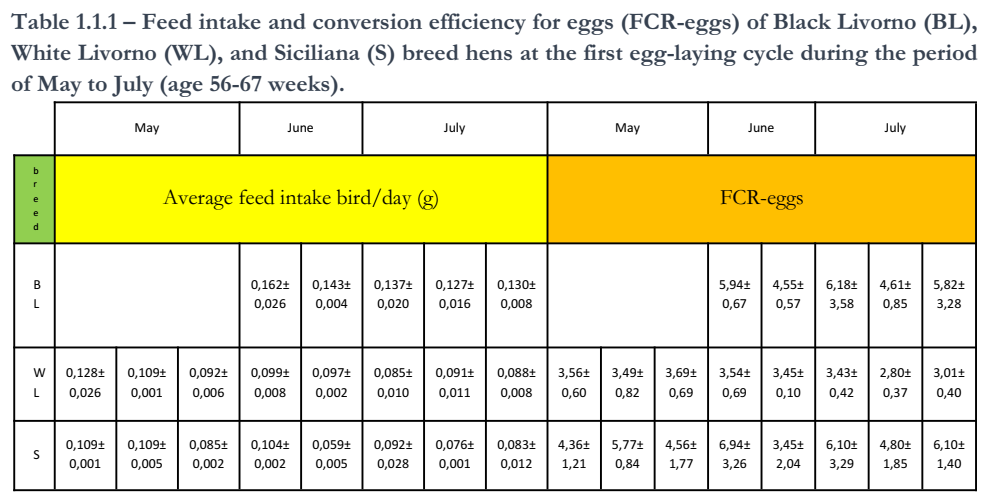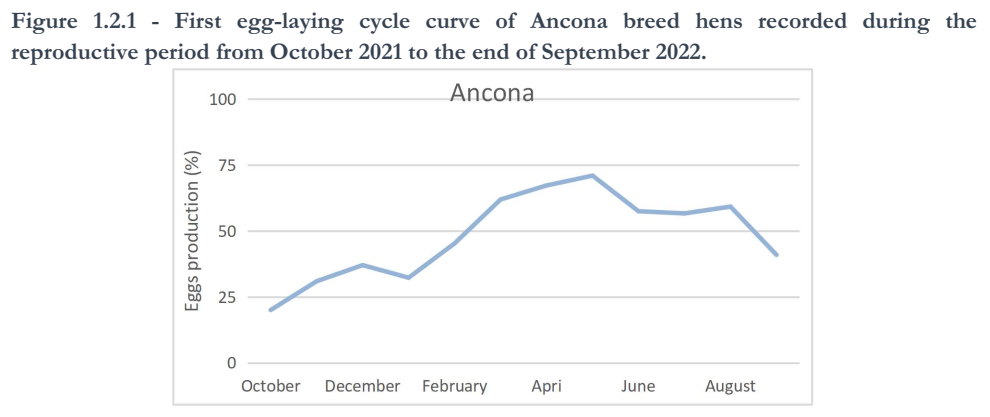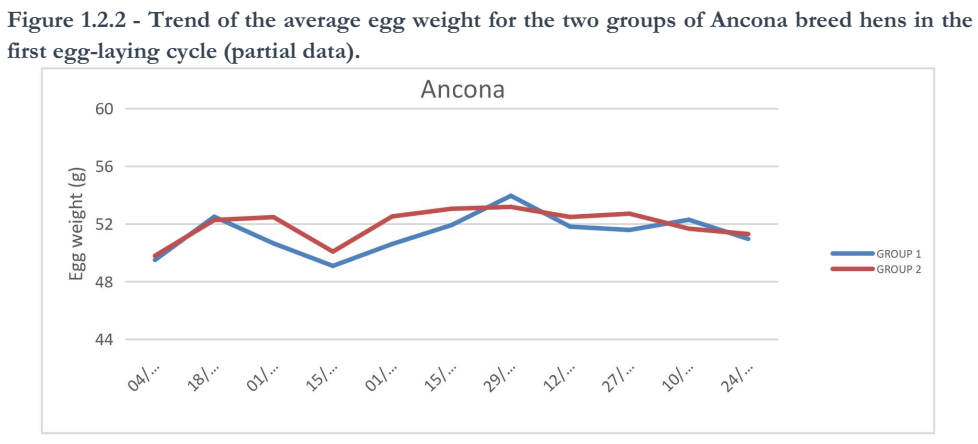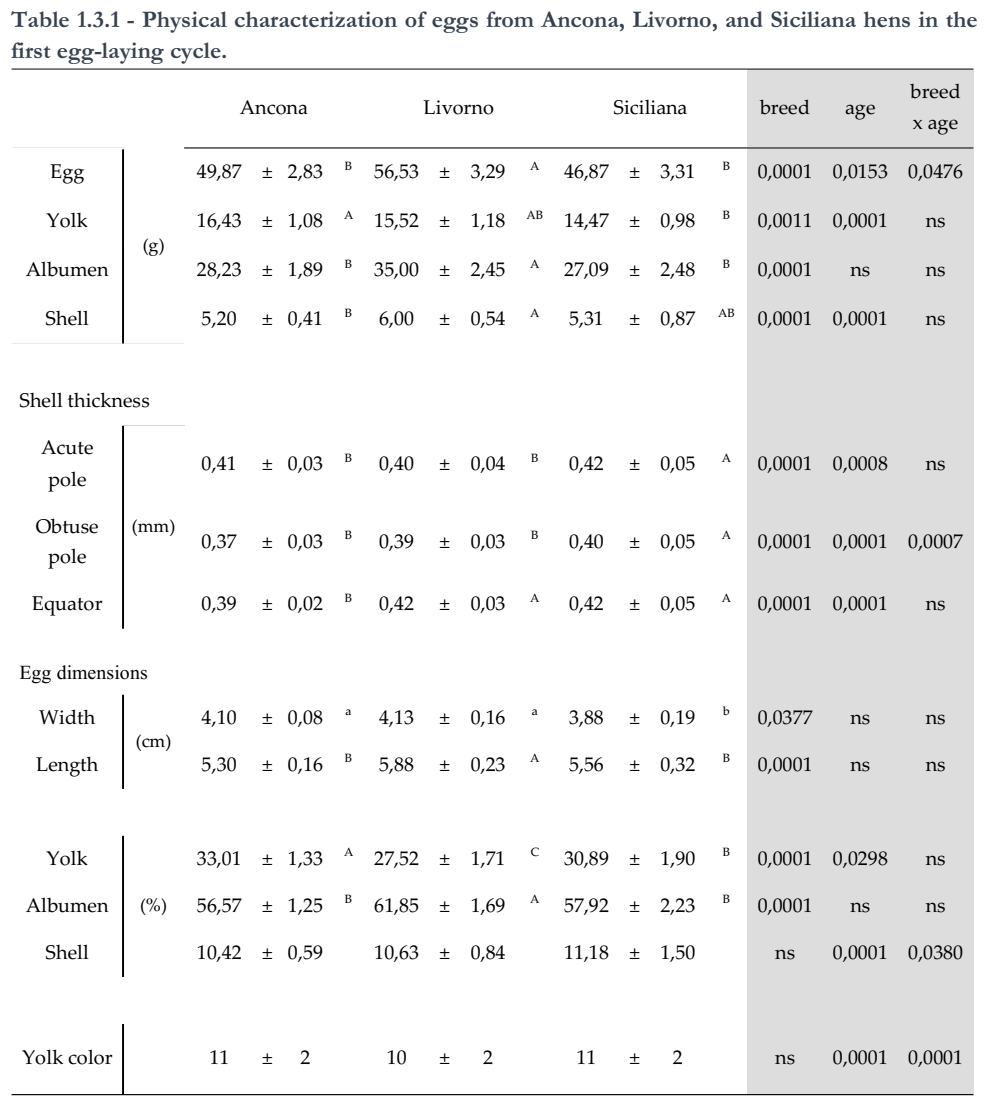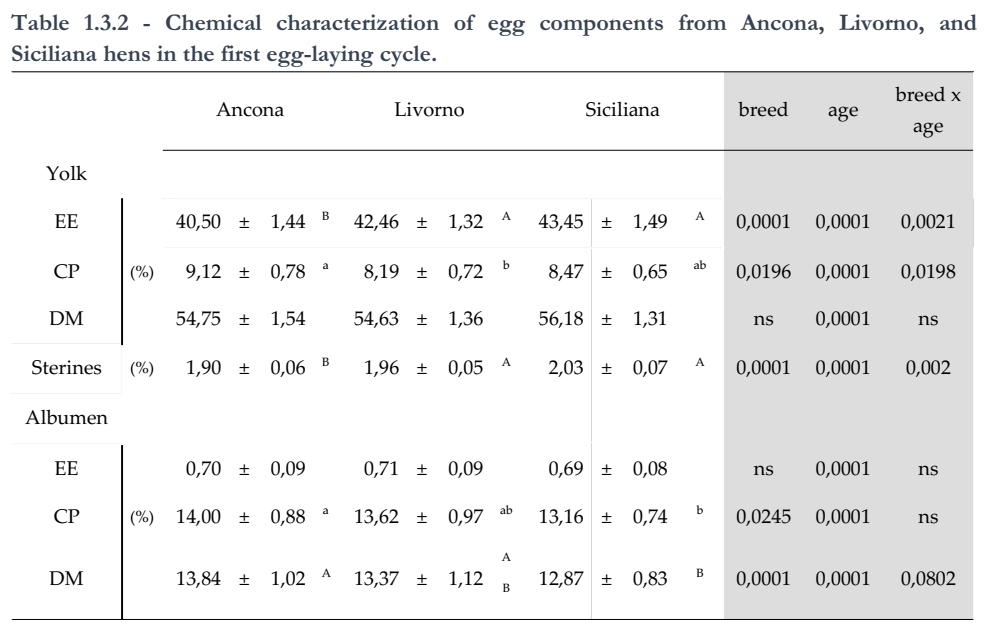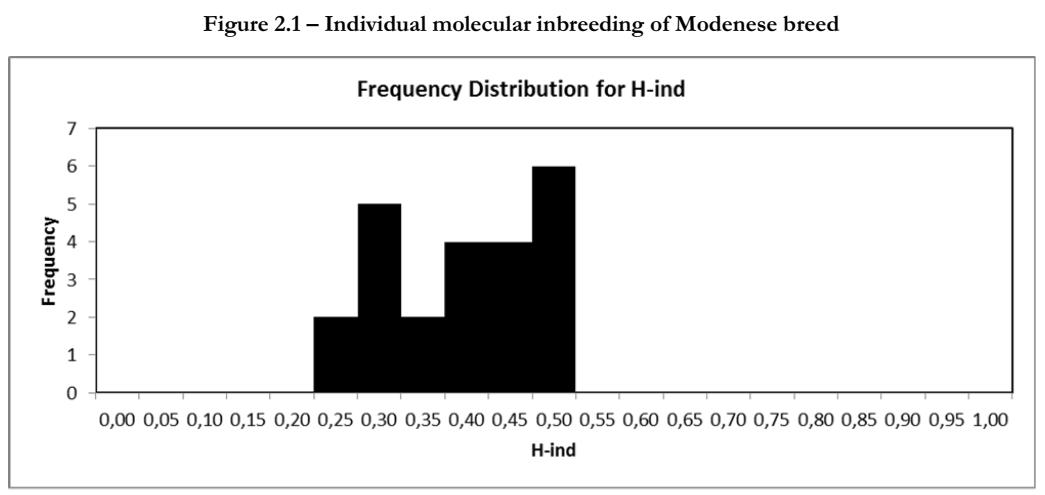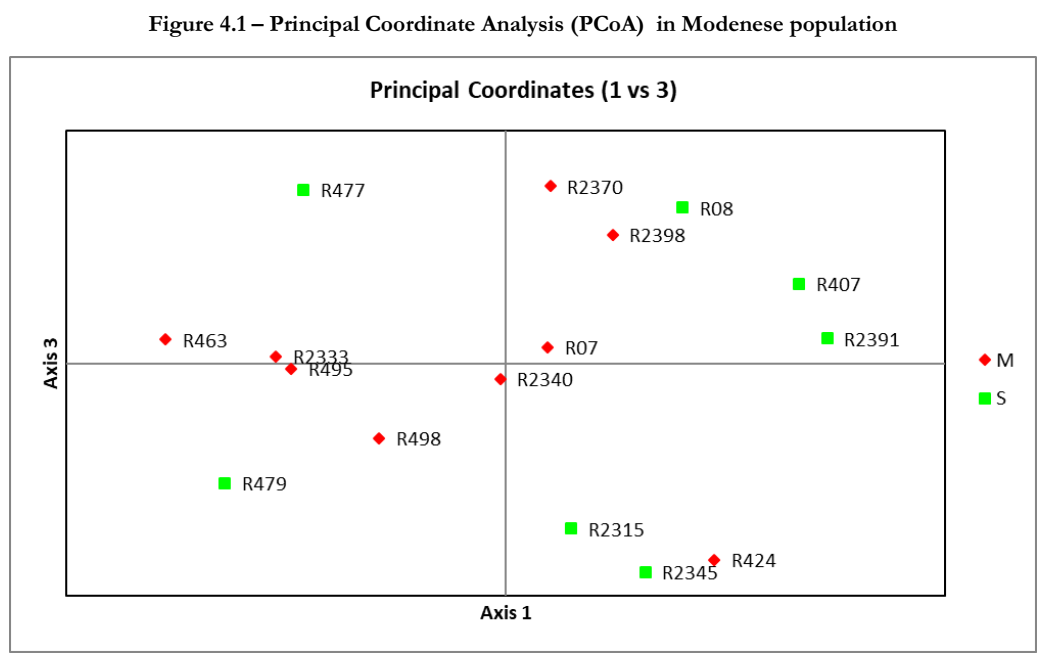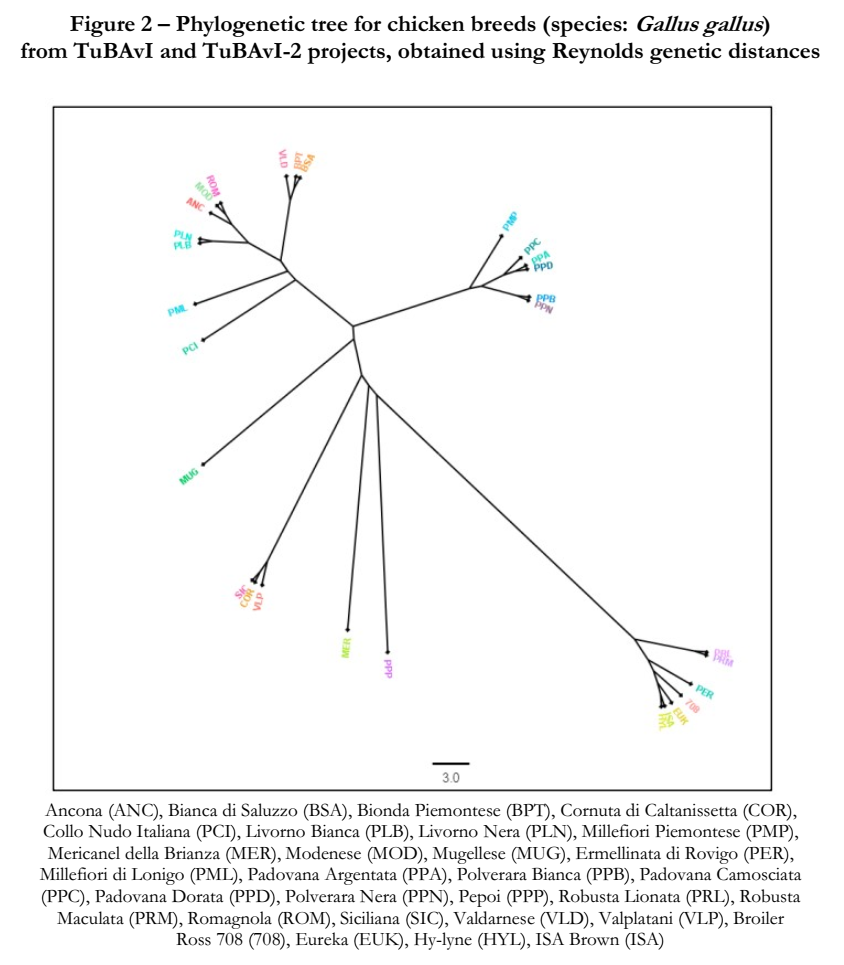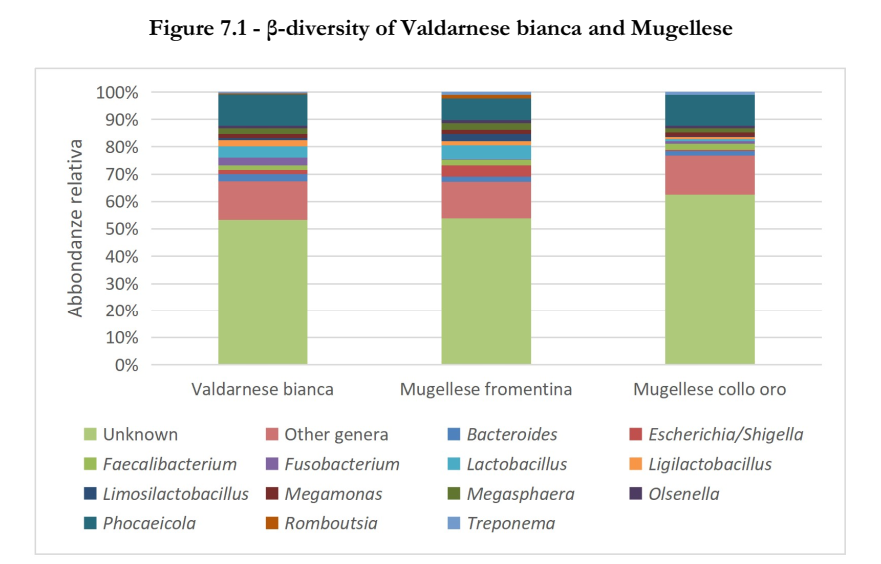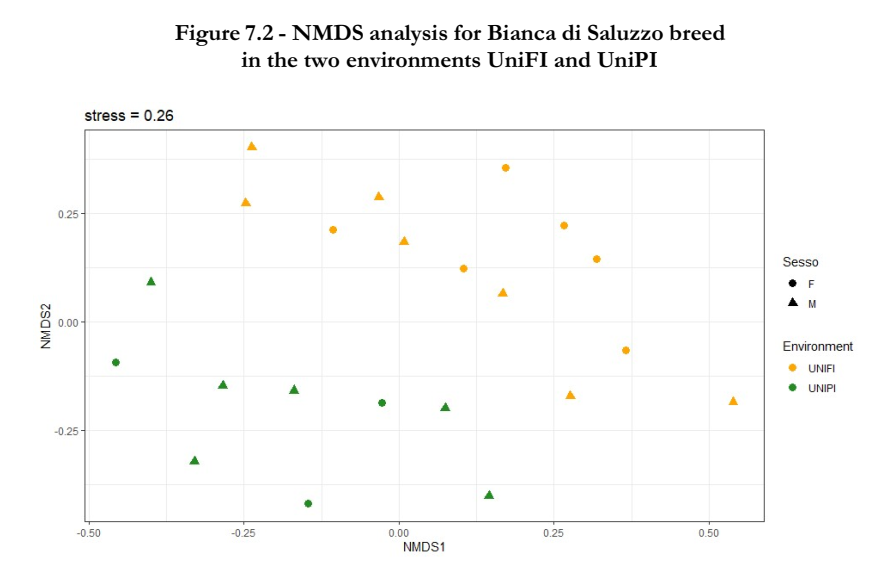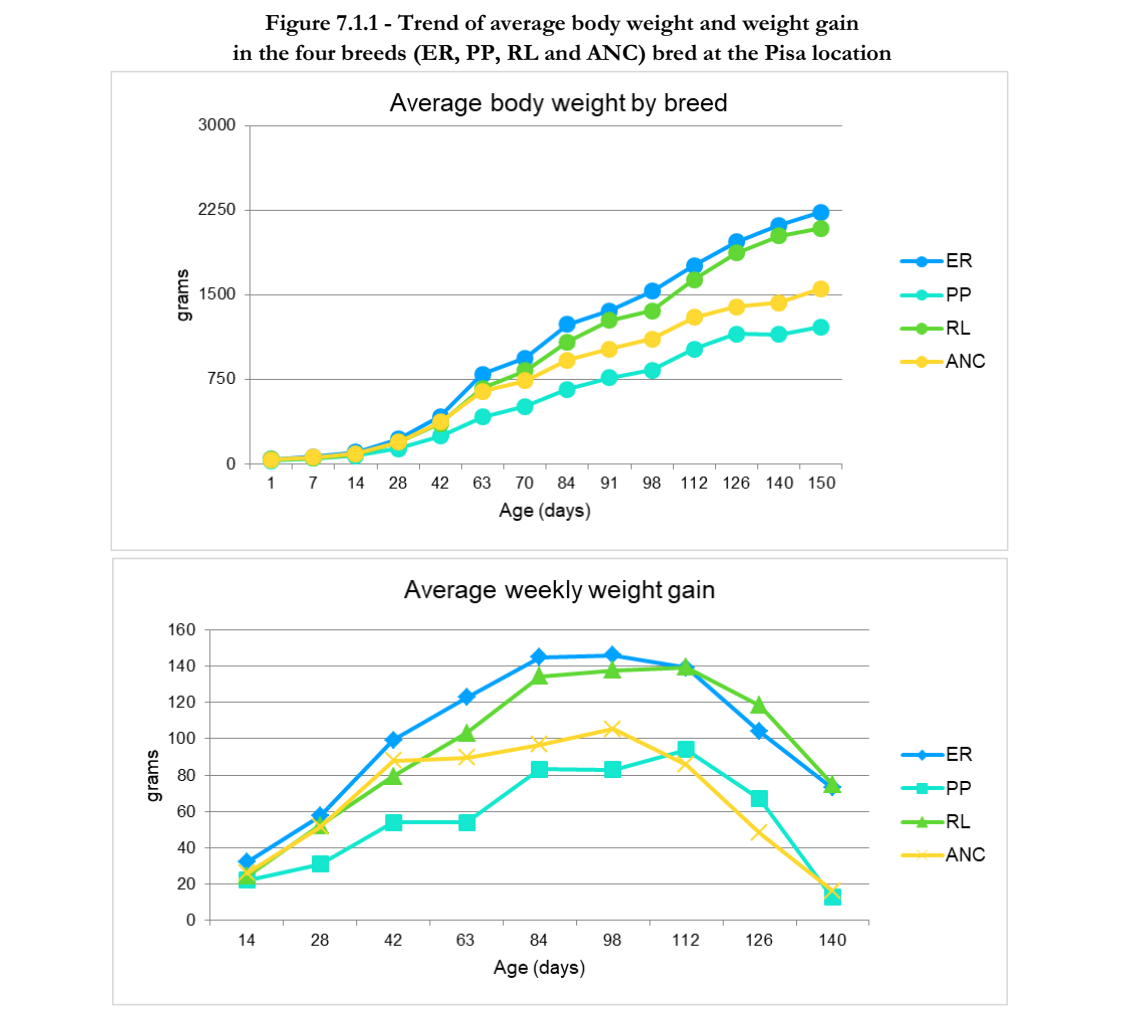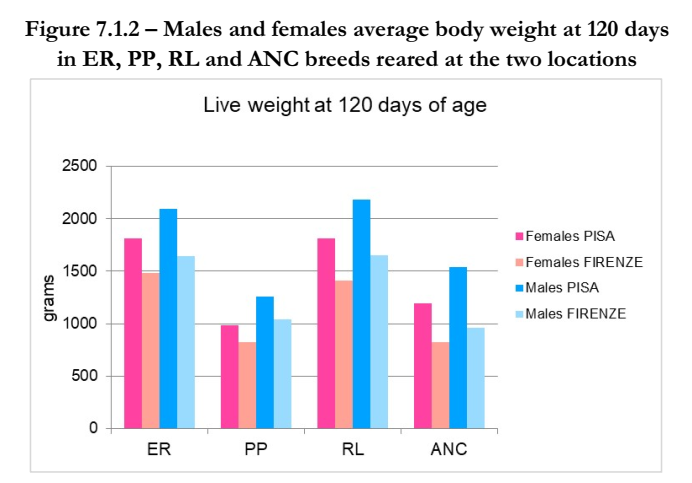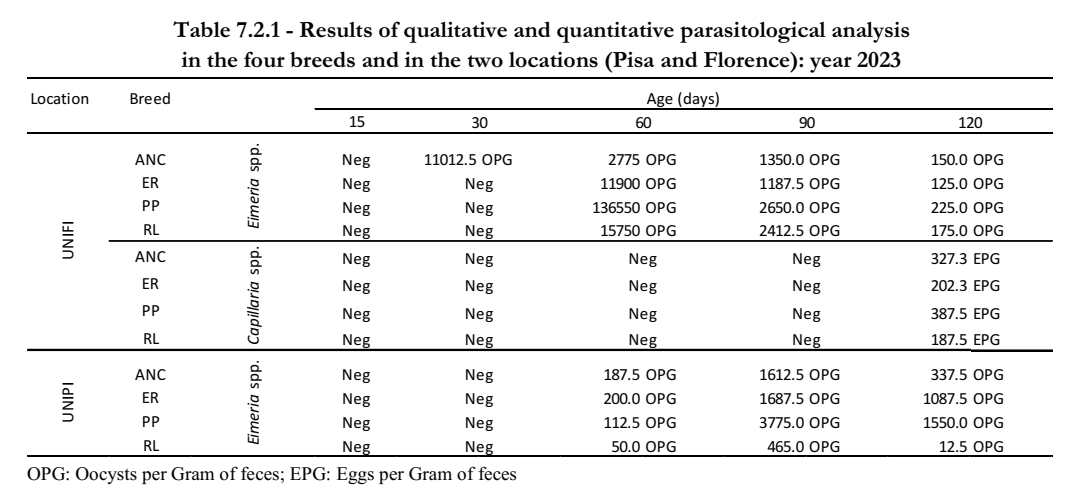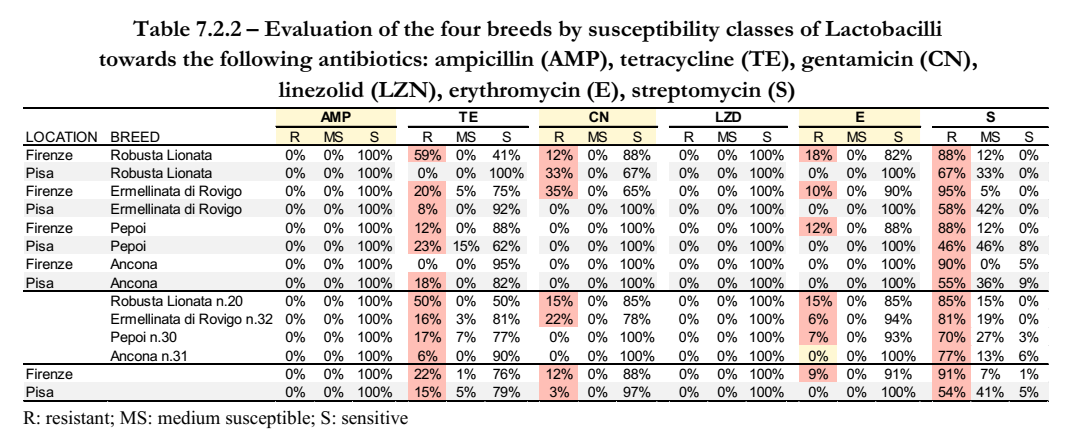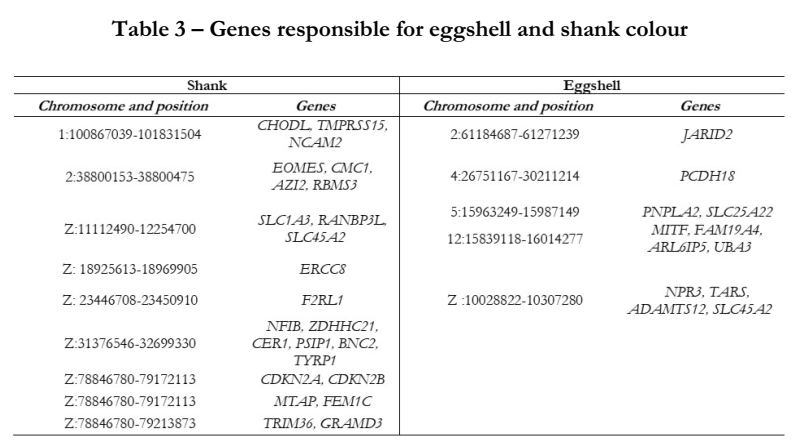Action 1 – Phenotypic characterisation
University of Milan
Phenotipic characterisation of Mericanel della Brianza (MB) chickens The reproductive period of the Mericanel della Brianza chickens selected during the second year was still ongoing in May 2023 and was concluded in July. Oviposition performance data were described in the previous activity report and a constant decline in egg production was observed in the period May-July 2023. Eggs set in May were incubated to select new breeders; the following average values were registered: fertility = 82.6%, hatchability/incubated eggs = 71.5%, hatchability/fertilised eggs= 86.4%. Total 190 chicks were hatched, individually marked on hatch.
Chicks were reared in a floor pen with controlled environment during the growing period; at 40 days of age birds were sexed and males and females reared separately from then on. The chicks underwent vaccination programme as follows: a) Marek disease, at 1 day of age; b) Newcastle disease, at 1, 4, and 20 weeks of age; c) salmonellosis, at 1, 7, and 18 weeks of age. Body weight was registered in 86 sample birds on 30, 60, 127, 142, and 190 days of age to monitor the growth curve; at 190 days of age, average body weight was 966 g (DS=110 g) in males and 769 g (DS=108 g) in females, in accordance with the standard body weight of the breed. In July, all males (n=82) were sampled (feathers) and genotyped in order to set mating plans according to individual variablity index (external service UniTO). Female breeders were selected according to kinship and to the numbers of birds avaiable for each family line. Overall, 48 female and 6 male breeders were selected (together with further 10 spare males). Sexual maturity occurred on 21 weeks of age and weekly oviposition rate progressively increased from 1 to 23% in the period October-December 2023.
Selected breeders were organised into 6 familiar lines, reared in floor pens with controlled environment starting from January 2024; moreover, additional 10 selected males were reared. Data on familiar lines are reported in Table 1.1. The reproductive period is ongoing; planned activities include: a) daily recording of egg production (number and weight) per family line, b) individual morphological charaterisation, c) incubation of eggs in the period April-May to monitor fertiliy and hatchability of family lines. The weekly oviposition rate (%) recorded so far increased from 19% to 39% during January and then has remained constant during the following months.
Phenotipic characterisation of Modenese (MO) chickens During 2023, new Modenese (MO) birds were found in fancy farms and new adults (13 females and 7 males, 180 days of age) were housed to the Poultry Center on October 2023. A quarantine period was observed to run sanitary tests, then rearing started in December. The birds were individually marked, weighted, and sampled (feathers). Samples were sent to the Molecular Genetics Laboratory (UniTO) for microsatellite marker genotyping in order to analyse individual variability and kinship. Analyses identified 3 familiar lines (Figure 1.1) and were used to set a mating plan to reduce consanguineity. Data on familiar lines in reproduction from March 2024 are reported in Table 1.2. Each familiar line is reared in a floor pen with controlled environment.
Morphological caracterisation of individual breeders showed omogeneous qualitative traits, consistent with wheaten gold colour: yellow shanks, white ear-lobe, orange/yellow eyes, red simple comb with 5-6 spikes, falling to one side in the hen; average values of quantitative morphological traits are reported in Table 1.3. Occasional ovoposition was registered during November and December 2023, and a costantly increasing weekly oviposition rate (4% to 46%) has been observed starting from January until now. Like MB breed, reproductive data recording is still ongoing, and hatching of the progeny for the selection of young breeders is expected in June.
Phenotipic characterisation of Nero d’Italia (NI) and Brianzolo (Br) turkeys
Brianzolo breed (BR) – The reproductive period of the three couples of Brianzolo (BR) breed, started during the second year, continued during May-July 2023 in controlled environment. Oviposition was constant in the period March-July 2023, after a period of sexual rest (see Report on the activities of the second year); oviposition rate was low, not higher than 29%, and individual egg production was 25 eggs/16 oviposition weeks. All breeders were moved to outdoor enclosures from August to December 2023; occasional oviposition was recorded during this period only in September and October. Eggs set during the period April-May 2023 were incubated, fertility was 96%, embryonic mortality 21%, and hatchability/incubated eggs 75%, corresponding to 18 hatched poults.
Poults, marked and weigted on hatch, were reared in floor pens with controlled environment up to adult age. Poults underwent vaccination for Newcastle disease at 1, 4, and 19 weeks of age. Body weight was registered on 4, 10, 16, 21, 30, 33, and 35 weeks of age and average registered values are reported in Table 1.4 for males and females. Body weight from hatch to 16 weeks of age was very similar in both sexes, while males showed a higher body weight increase in the following weeks. Birds were moved to outdoor enclosures in the period August-December 2023 and then again to controlled environment in the following months. Mortality rate during the growing period was 11% (2 birds), then 5 females and 11 males reached adult age. Sexual maturity in females occurred on 30-31 weeks of age, in December.
At the beginning of March 2023, familiar lines were organised: 1 group with 3 females hatched in 2022 (TV), and 2 groups with 5 females hatched in 2023 (TG, 2 females in one group and 3 females in the other). It is planned to mate TV females in turn with each of the 3 males hatched in 2022, and TG females with males hatched in 2023, randomly chosen, and changed every third week. It is planned to set eggs three times along the period April-May 2024 in order to select young breeders. Reproductive traits recording is ongoing and will be completed in July 2024. Along the period January-March, weekly oviposition rate of TG females increased constantly from 6% to 80%, while TV females started oviposition in March, with an average weekly oviposition rate of 26%.
All the reared turkeys were sampled (feathers) in November 2023. Samples were sent to the Molecular Genetics Laboratory (UniTO) for microsatellite marker genotyping in order to analyse population structure and kinship.
Nero d’Italia breed (NI) – A new group of Nero d’Italia turkeys (n=10) was housed to the Poultry Center on July 2023, in order to set a nucleus population. A quarantine period was observed to run sanitary tests, then rearing started in September. All the birds were marked, sexed, then males and females were parted and reared in outdoor enclosures in the period September-December, and in floor pens in controlled environment in the following months. Body weight was registered on 98, 126, 160, 190, and 220 days of age; growth curve for males (n=3) and females (n=7) is reported in Figure 1.2. Sexual maturity of females occurred on 45 weeks of age in Aprile and oviposition traits recording is ongoing. At the beginning of March, 3 family lines were organised, each made of 2-3 females and 1 male; it is planned to rotate the males from one familiar line to another every third week. In the period April-May, three egg settings are planned in order to select new breeders.
All the birds were sampled (feathers) in November. Samples were sent to the Molecular Genetics Laboratory (UniTO) for microsatellite marker genotyping in order to analyse population structure and kinship.
Phenotipic characterisation of semen in chicken and turkey breeds
Proteome – The functional informatic analysis of shared and exclusive proteins of different chicken breed semen was concluded during the third year. Preliminary results will be presented in a poster at the European Poultry Congress (Valencia, Spain) in June 2024. Complete results are being organised to prepare a paper to be submitted for the publication to an open access specialised journal of the field.
Lipids – Verification and organisation of the laboratory data produced in previous months were concluded in 2023. At present, statistical analysis of final data is being planned, in order to obtain results on any difference among breeds in lipid composition of the semen. It is planned to present the data in a final report.
Semen production and quality – During the third year, semen production was evaluated in MO chickens and in BR and NI turkeys. Males from different breeds, reared as described before, were used for semen collection in the period December-March, before the familiar lines were organised. Semen collection was routinely performed twice weekly and semen quality was regularly evaluated. Average values of quali-quantitative parameters recorded in individual ejaculates for MO and BR breeds are reported in Table 1.5. NI turkeys did not produce ejaculates on milking for semen collection.
University of Florence
Phenotypic characterisation of chickens of the Mugellese, Valdarnese Bianca and Valdarno breeds The breeders of the Mugellese, Valdarnese Bianca and Valdarno breeds were reared at the Experimental Farms of the Department of Agricultural, Food, Environmental and Forestry Sciences and Technologies (University of Florence). They were divided into 3 families by breed and livery and raised on the ground, in separate boxes on permanent litter. Two additional families for the Mugellese breed (1 x livery) are still reared in natural hatching in an environment that simulates a wild territory (tree and shrub cover). All subjects were bred in compliance with the guidelines of poultry farming and the regulations in force on animal welfare.
Characterisation of the breeds:
- Morphological characterisation, according to the FAO guidelines (2012) to update and validate what was collected during the first TuBAvI project for the Mugellese (Mannelli et al., 2023) and Valdarnese bianca breeds (manuscript work in progress; fig. 1.1) and first characterisation of the Valdarno breed (data elaboration in progress);
- Weight gains (for the Mugellese breed shown in Mannelli et al., 2023 and for the Valdarnese bianca breed shown in Fig 1.2), feed consumption and feed conversion index calculation for the three breeds reared in UniFI farm (for the Mugellese breed shown in Mannelli et al., 2023; for Valdarnese bianca and Valdarno breeds the data validation and processing are in progress), evaluation food consumption with reference to the production of eggs in the families formed after the breeding plan (data collection in progress);
- Daily egg production (for the Mugellese breed reported in Mannelli et al., 2023; for the Valdarnese bianca breed data reported in Fig, 1.3; for the Valdarno breed data collection in progress).
The morphological, growth and deposition data reported for the Mugellese breed and published in Mannelli et al., 2023 are under validation through further data collection and, in order to consider the two liveries as two distinct populations, the families belonging to the two standard liveries have been separated.
Phenotypic characterisation of chickens of the Mugellese, Valdarnese bianca and Valdarno breeds Following the breeding plan carried out by the consultant UniTO (including samples collected form others breeders), families were formed at the UniFI Experimental farm, following the indications for the mating plans and, starting from these new nuclei, a selection program was started following phenotypic characteristics of the progeny for the Mugellese breed in the two liveries, while for the white Valdarnese bianca and Valdarno breeds the nuclei were formed at the beginning of 2024, also following the breeding plan carried out by UniTO. We are now awaiting for the hatchings to carry out also the phenotypic selection of the progeny on these nuclei.
University of Padua
Phenotypic characterization of autochthonous breeds and species During the third year of the project, blood samples and phenotypic characteristics were collected on animals of the following species/breeds:
- Collo Nudo Italiana breed (species: Gallus gallus) (n = 48)
- Oca Padovana breed (species: Anser anser) (n = 53)
The collection of the above information led to the completion of the activity of recording morphometric measurements and collecting biological material (blood) required by the TuBAvI-2 project. Table 1 summarizes the qualitative phenotypic characteristics (shank and skin color) of all species/breeds involved in the project, and Figure 1 depicts the descriptive statistics (mean and standard deviation) of quantitative phenotypic characteristics (body weight, body length, shank length, shank circumference, wingspan, sternum circumference) recorded on the same species/breeds. Phenotypic characteristics are presented for males and females within breed and follow the guidelines of FAO (Phenotypic characterization of animal genetic resources. FAO Animal Production and Health Guidelines, 2012).
University of Perugia
Phenotypical characterisation and performance evaluation of Livorno and Ancona breeds, phenotypical characterisation of Robusta maculata breed Action 1 activities were carried out in previous years, the data are published on the pages dedicated to year 1 and year 2 results of the project. The Ancona, Livorno (Bianca, Nera, Dorata and Argentata) and Robusta Maculata breeds are currently preserved at the poultry center of the University of Perugia. As in previous years, the best subjects for each breed have been selected and therefore each breed was organised into two families with approximately 10-13 female and 3 male subjects. To avoid inbreeding problems, each subject is individually marked with a chip. Through the use of a reader, the chip reports all the information regarding the kinship.
Characterisation of the adaptation to low-input breeding systems and evaluation of the performances of the native breeds The evaluation of the adaptability to extensive farming systems characterised by low-input farming (use of local raw materials, moderate energy and protein intake) and “natural” environmental parameters (temperature, humidity and light) was completed, in particular, the ability to adapt to conditions of high temperatures (heat-stress) typical of the summer season has been evaluated.
Behavioural characterisation of the Ancona breed The study protocol of the following test, like the protocol used for Leghorn behavioural characterisation, concluded during the second year, was submitted and accepted by the University Committee of Bioethics (prot n.76527 of 3/3/2022). The trial involves the use of 54 hens and 6 males of Ancona, the housing occurred the first week of June 2024 at 14 weeks of age. The animals were divided into two experimental groups:
- one group reared indoors: the animals were housed in 3 boxes without outdoor access with a density of 10 animals/m2. In each box 9 females and 1 male were housed for a total of 27 females and 3 males. This experimental group act as the control group.
- one group with outdoor access: the breeding area is characterised by the presence of three outdoor parks each with a shelter for the animals in which the following densities was used: external 10 m2/head, internal 10 animals/m2, inside each shelter will be placed 2 feeders and 2 drinking troughs. In each pen 9 females and 1 male were housed for a total of 27 females and 3 males.
The experimental test for the characterisation of the Ancona breed has been completed. In particular, the behavioral trial was carried out during the months of June and July 2023, during the recordings the minimum and maximum temperatures of the day were noted. The test, as for the previous breed, produced a total of 12 hours of outdoor recording and 12 hours of indoor recording carried out using the Noldus XT software. The test was carried out using the same devices, structures and methods used for the characterization of the Leghorn breed. For this reason, individual devices (bibs) were applied to the individual animals, each outdoor areas and internal boxes had UWB Anchors positioned at the antipodes, 1 UWB Tag positioned in the centre, 1 UWB Gateway, 1 computer to collect the raw files and 10 chips placed on the bibs (Figure 1). The software was able to produce a raw report for each animal with a precise recording of the behavior every 2 seconds, detecting its spatial position within the four quadrants of the area and the Cartesian axis (x, y, z), indicating the peck and the distance covered (Figure 2).
University of Molise
Phenotypic characterization of a Siciliana breed conservation nucleus As part of this task, 28 Siciliana (SI) breeders were raised at the Molise farm, which had been previously agreed. The birds were organized into 2 families and raised outdoors with access to night shelters, following standard poultry breeding guidelines.
Two incubations of SI breed were carried out to verify the level of fertility and hatchability; the results recorded are shown in table 1.1.
Evaluation of the productive characteristics of Siciliana breed chickens at a social farm located in Puglia Within the activities for the turnover of the SI breed conservation nucleus planned for 2023, 3 families were formed based on the genetic analysis performed on a group of 44 individuals (30 females and 14 males). The formation of the families took place considering the genetic distances between the females, the males were identified based on molecular kinships. Each family consisted of 1-2 males and a group of 8-12 females. All subjects were raised at a social farm located in Foggia – Apulia region (Cooperativa Emmaus), which is committed to the protection of animal biodiversity within a socially beneficial community. The project has created a small rural breeding farm of SI subjects. The social farm represents a rural production model that is perfectly suited to local breeds, thus contributing to their conservation and promotion.
Phenotypic characterization of Romagnolo (RO) and Ermellinato di Rovigo (ER) turkeys During 2023, 20 RO-breed and 15 ER-breed turkeys were reared at the agreement farm located in the municipality of San Giovanni Rotondo (FG). The live weight of male and female RO-breed individuals was recorded monthly. The mean weights, expressed as mean ± standard deviation from the first day of life to 180 days, are presented in Table 1.2. Mortality recorded up to 6 months was 40%. Oviposition in the two breeds started in January and peaked in the second half of March in the RO breed and at the end of March in the ER breed. A gradual decrease in oviposition rate was observed from the third week of June. The average number of eggs produced by each turkey hen was 65 for the ER breed and 70 for the RO breed. Adult individuals of both breeds (n = 6, RO; n = 5, ER) were subjected to morphometric measurements according to the FAO 2012 guidelines. The mean values of the quantitative traits recorded are presented in Table 1.3.
Two incubations of eggs were performed for each breed to assess the level of fertility and hatchability, and the recorded results are presented in Table 1.4.
Phenotypic characterization of Collo nudo italiana chicken breed In the project proposal submitted, it was planned to maintain the Bianca di Saluzzo breed. Later, in agreement with the other PAs, this breed was replaced by the Collo Nudo italiana breed, as there was no conservation nucleus of this breed yet. In October 2023, the request for replacement of the breed was approved by the Ministry, and activities were started to breed a group of Collo nudo italiana chickens. All individuals (n = 40) were raised outdoor at the Apulian farm. Activities are underway to evaluate oviposition and reproductive performance of the following zootechnical parameters: daily oviposition, egg weight, fertility, and hatching. Morphometric measurements were carried out on the available adults and the data obtained are presented in Table 1.5.
A preliminary artificial incubation test was carried out on 26 eggs in 2024, with a recorded fertility rate of 84.6% and a hatching rate of 76.9%.
Phenotypic characterisation for the assessment of innate immunity In the present task, the immune resilience of two turkey breeds (RO and ER) was monitored, considering the following markers: complement component 3 (C3), IgY, and lysozyme C (LYZ). Blood samples were collected from 5 males and 5 females of each breed. After coagulation (2 hours at room temperature), the samples were centrifuged at 3000 rpm for 20 minutes, and the resulting serum was stored at -20°C. The quantitative analysis of lysozyme C (LYZ) was conducted using a competitive enzyme immunoassay technique (ELISA kit), while a quantitative sandwich ELISA kit was used for the determination of complement component 3 (C3) and IgY. Optical density was measured at 450 nm using the Tecan-Infinite® M Nano model plate reader.
Table 1.6 presents the results obtained. The GLM procedure was employed to determine the effects of the considered variables (breed, sex, and their interactions) on the evaluated immune markers. A significant effect of breed and sex was observed only for LYZ. Significantly higher values of LYZ (ng/mL) were found in ER males, whereas in the RO breed, the highest values of this marker were observed in males compared to females (p<0.05). Although higher levels of C3 (µg/mL) were observed in males of both breeds compared to females, no significant differences were noted. IgY concentrations did not show significant differences between breeds and sexes, but the RO breed exhibited higher concentrations (mg/mL) than the ER breed. Understanding the parameters analyzed provides a preliminary insight into the immune status of these breeds, offering a useful framework for assessing their health and responsiveness to pathogens.
Phenotypic characterisation of fresh semen The assessment of fresh semen quality was carried out for the following turkey breeds: RO and ER. The following quanti-qualitative parameters were evaluated: sperm volume and concentration, cellular membrane integrity (by flow cytometry) total sperm motility, progressive motility, and kinetic parameters (by CASA system with SCA software).
The results obtained from the assessment of fresh semen quality of the native turkey breeds considered are reported in Table 1.7.
Lipid profile analysis was performed on the spermatozoa of SI breed roosters, using the Folch’s method to extract total lipids with a commercial kit (Fatty Acid Extraction Kit, Low Standard – Sigma Aldrich). The total lipids were separated into the neutral lipid classes by thin layer chromatography. Total phospholipid, triglyceride, free fatty acid and cholesterol ester classes were subjected to reflux trans-methylation followed by determination of fatty acid composition by gas chromatography. FAMEs were separated on a capillary column (Zebron ZB-FAME 30 m × 0.25 mm × 20 µm). The fatty acids of the samples were compared with the peak retention times of the 37 FAME standard (Supelco). Analysis and organisation of the data are in progress.
University of Pisa
Phenotypic characterisation of Livorno, Siciliana, Bianca di Saluzzo, Bionda Piemontese, and Millefiori Piemontese chicken breeds During the period under consideration, Livorno (L) and Siciliana (S) chicken breeds, hatched in April 2021 and raised at the Poultry Breeding facility of the Department of Veterinary Sciences at the University of Pisa, completed their second laying cycle by October 2023. All animals were raised on sandy soil in outdoor enclosures with partial roofing, under natural light and temperature conditions.
Monitoring of daily egg production continued until the end of October 2023 (see figure 1.1.1), while egg weight evaluation (see figure 1.1.2) and egg morphometric determinations of second-laying eggs were completed by the end of June (data in processing). The assessment of food consumption by second-laying hens was completed by June 2023, and the egg FCE was calculated (see table 1.1.1). Replacement subjects born in April 2023 were monitored for growth, mortality, and morphometric characteristics as outlined in the project (data in progress).
The data concerning the Piedmontese breeds Bianca di Saluzzo (BS), Bionda Piemontese (BP), and Millefiori Piemontese (MP) preserved at the Poultry Centre for the Conservation of Local Genetic Resources (Carmagnola, TO – supervised by Prof. Achille Schiavone) have been collected and are made available as part of the technical consultancy contract between UniPI and UniTO starting from 05/03/2022 (refer to the technical report by the UniTO consultant).
Phenotypic characterisation of Ancona (A) breed chickens Monitoring of daily egg production during the second egg-laying cycle of Ancona hens continued until the end of October 2023 (see figure 1.2.1), while egg weight detection concluded in July (see figure 1.2.2).
Characterisation of laying hens’ adaptation capacity to seasonal environmental stimuli In 2023, the qualitative characterisation of the yolk and albumen of the eggs produced during the second cycle of laying of the L and S breeds was completed in June. The egg components were evaluated (see table 1.3.1), and chemical analyses of the yolk and egg white were conducted (see table 1.3.2).
Action 2 – Genetic characterisation
University of Milan
Sequencing of genome in Meleagris gallopavo speciesGenomic data were obtained in May 2023 and statistical analysis was performed in the following months. Final results have been organised and presented as a scientific report for the publication on Plos One. The review of the manuscript is still ongoing.
University of Padua
The genetic analyses conducted by the external service/laboratory starting June 2023 enabled the acquisition of genotypes for all species/breeds involved in the project. Starting with DNA extracted from blood samples (about 2 mL) and stored in tubes with EDTA at -20°C, genotyping of animals was carried out using SNP molecular markers. Two distinct approaches were used, depending on the species:
- Collo Nudo Italiana and Millefiori Piemontese breeds (species: Gallus gallus) → Affymetrix Axiom Chicken 600K HD;
- Anatra Mignon and Anatra Germanata Veneta (species: Anas platyrhynchos), Oca Padovana (specie: Anser anser) and Faraona Camosciata (specie: Numida meleagris) breeds → low-coverage whole genome sequencing (WGS – coverage 4X).
The WGS approach for the species Anas platyrhynchos, Anser anser and Numida meleagris was used because there are no commercially available SNP chips with which to perform the same genotyping.
University of Turin
Genetic characterisation using microsatellite markers Genetic characterisation with microsatellite markers is planned to provide useful tools for the conservation of biodiversity in nucleus populations managed by Partners and in the semen Cryobank. Specifically, the following objectives are considered: 1) Identify male candidates for replenishment and semen production; 2) Characterize new genetic lines in breeds under conservation; 3) Characterize new chicken breeds.
Characterisation of male candidates For the characterisation of candidates for semen production, 20 subjects of the Ermellinata breed and 16 subjects of Robusta Lionata were analysed. For replenishment and management plans, candidates present in the conservation nuclei of UniMOL (Siciliana, 44), UniFI (Mugellese, 49; Valdarnese, 55; Valdarno, 49), UniTO (Bionda Piemontese, 62; Bianca di Saluzzo 58) and UniMI (Mericanel della Brianza, 70) were characterised. A total of 423 subjects of the Gallus gallus species present in the conservation Centre were analysed. Additionally, 32 turkey subjects (genus Meleagris) were characterised.
Identification of new genetic lines in the Modenese chicken breed Twenty-three subjects belonging to the Modenese breed were genetically characterised to identify new genetic lines. To estimate the inbreeding rate, the average observed heterozygosity (Ho=0.41) was analysed, and median, standard deviation (SD), standard error (SE), maximum, and minimum values were reported. The Hardy-Weinberg equilibrium test shows a significant deviation from equilibrium only in some loci. The graph in Figure 2.1 shows the distribution of individual molecular inbreeding (H-ind) in the analysed population. The overall distribution follows a bell-shaped curve, with the distribution skewed to the right (generally high values of individual variability).
Action 4 – Genetic indexes and mating plans
University of Florence
Valdarnese bianca and Valdarno birds were sampled, as planned, to perform genetic characterisation in order to prepare mating plans. Feathers were sampled from 56 Valdarnese bianca birds from UniFI and from 9 breeding farms on the territory and from 52 Valdarno birds from UniFI and from 10 breeding farms on the territory. All the samples were sent to consultant UniTO to evaluate genetic indexes and the results were used to form the new families and were shared with breeders who had participated in the sampling.
University of Padua
The analyses following data quality control have been concluded for the species Gallus gallus and they are still in progress for the other species. The following genetic diversity indices were estimated for the chicken breeds: observed heterozygosity (Ho), expected heterozygosity (He), minimum allele frequency (MAF) and Runs of Homozygosity (ROH), i.e., portions of DNA that are identical on both chromosomes within the population and their respective islands of origin (Table 2).
University of Turin
Selection of males for reproduction and semen production Typing data were used to calculate the kinship matrix by evaluating the number of alleles shared for each pair of individuals belonging to the same breed. The average kinship among all breeders (P) and the average kinship with family lines (Pf) were then calculated. Principal Coordinate Analysis (PCoA) was used to highlight the existing genetic variability in the sampled groups. The results were graphically represented (Figure 4.1) to make the genetic differences between the subjects evident. As an estimate of inbreeding, the average observed heterozygosity was analysed, along with the number of samples (N), number of different alleles (Na), number of effective alleles (Ne), Shannon Index (I), effective heterozygosity (He), and fixation index (F). Observed heterozygosity is very low (0.24-0.33) in Veneto populations, but the percentage of polymorphic loci is 73%, and the overall average kinship is also high. For male selection plans, the individual variability index (H-ind) and genetic distance (DPS) were estimated. Based on the results of the analyses previously reported, to maximise the selection of males, the individual variability indices (H-ind) and the degree of kinship (P or Pf) were combined into a new conservation index (C) calculated as the difference between H-ind and P/Pf. The index ranges from 1 to -1, with high values indicating low inbreeding and greater genetic variability. Based on the C index, individuals with an index value above the population average were identified.
Reproductive management For mating plans, the individual variability index (H-ind) and the average kinship index (P) concerning all analysed subjects were estimated. Subjects with higher H-ind allow for the conservation of greater genetic variability, while those with lower P help to contain the increase in inbreeding. Matings were made by calculating the average kinship of typed males with the subjects of each family present in the conservation nucleus. The selection of breeders was carried out to cover the greatest existing variability, taking into account individual heterozygosity using the conservation index (C). Matings were planned between subjects belonging to different bloodlines to minimise kinship between the male and the female group. For each male, the average kinship between the females in the group and the selected male was calculated to minimise the inbreeding rate (∆F). The analysis results were reported in the genetic evaluation document sent to the UniMI coordinator and to the reference Partner. The indices will be published on the project’s website.
Action 5 – Assessment of inbreeding
University of Padua
In order to evaluate the enhancement of genetic resources and thus monitor the level of inbreeding in the Gallus gallus species, specific indices (FHOM and FROH) were estimated for each animal, based on the excess of homozygosity within the genome of the Collo Nudo Italiana and Millefiori Piemontese breeds. The results, in terms of within-breed averages, are shown in Table 2. The values, which can range from 0 to 1, indicate a low level of inbreeding of the two breeds and, therefore, an optimum level of genetic variability.
Action 6 – Monitoring of genetic diversity
University of Padua
Data from the TuBAvI-2 project for the species Gallus gallus were merged with data of the same species from the previous project (TuBAvI). This allowed the estimation of the phylogenetic relationship by exploiting Reynolds genetic distances and paint a picture of the closeness between different breeds belonging to the Italian local poultry heritage (Figure 2).
Action 7 – Genetic resistance traits
University of Florence
Regarding breeds under protection at UniFI, Mugellese and Valdarnese bianca were sampled at the end of 2021 and DNA was extracted from the collected samples, sequenced by third parties and processed to highlight any differences in the microbiota (fig. 7.1).
In this action, in collaboration with the PA UniPI, in 2022, the PA UniFI has evaluated the resilience and resistance to pathologies and environmental stresses of the Mugellese, Valdarnese bianca, Livorno and Bianca di Saluzzo breeds in terms of animal welfare and resistance to pathogens, using the response of the intestinal microbiota to environmental stimuli as an information marker. Subjects belonging to these breeds were bred in free-range and fed with the same feed (Monge) at our UniFI headquarters and at the UniPI headquarters, according to the same scheme. At the end of the test, the caecal feces of each test subject were taken from both sites. From the collected samples, DNA was extracted and sequenced by third parties and processed to highlight any differences in the microbiota (for the Bianca di Saluzzo breed the data is shown in Fig. 7.2).
In the following year 2023, the same experimental design was repeated but with Pepoi, Robusta lionata, Ermellinata di Rovigo and Ancona breeds. DNA sequenced by third parties was extracted from the collected samples. We are awaiting for the sequencing results.
University of Pisa
Evaluation of resilience for growth under environmental stimuli In September 2023, the growth test for the Ermellinata di Rovigo (ER), Ancona (ANC), Pepoi (PP), and Robusta Lionata (RL) breeds concluded. This test began with hatching at the end of February and was conducted at the UniPI and UniFI facilities. Figure 7.1.1 shows the body weights and growth rates of the Pisa animals during the first 150 days of life; consumption and ICA data are currently being processed. Total mortality rates (1-150 days of age) were 68.4%, 38.1%, 27.3%, and 25.0% for RL, PP, ER, and ANC, respectively, primarily due to colibacillosis, which manifested itself on the 14th day of the animals’ lives. Figure 7.1.2 displays the average body weights of 120-day-old chickens raised at the two sites.
Evaluation of resistance/resilience to bacterial and parasitic infections/infestations and resilience of intestinal microbiota Table 7.2.1 shows final results of the qualitative and quantitative parasitological analyses to detect coccidia (Eimeria spp.), nematodes (roundworms, capillaries, Heterakis spp.), protozoa (Giarda spp. and Cryptosporidium spp.) and Histomonas meleagridis in stool samples collected from the growing chickens monitored in the previous task.
At the age of 120 days, four individual cloacal swabs were taken from the same chickens at both sites to identify pathogens such as Salmonella spp., Clostridium perfringens, Campylobacter jejuni, and commensal bacteria such as Enterococcus spp., Lactobacillus spp., and Bifidobacterium spp. (data in progress) and to obtain isolates for evaluating the antibiotic resistance profile. Table 7.2.2 presents the incidence of the different breeds in the antibiotic susceptibility classes found in the Lactobacilli isolated from them.
At the end of the monitoring period, individual cloacal faecal sampling was conducted to characterise the intestinal microbiota of the chickens, performed by PA UniFI as part of its research program.
Action 8 – Germplasm collection
University of Milan
Collection of germplasm for the Semen Cryobank The Italian Semen Cryobank of Autochthonous Chicken and Turkey Breeds was implemented and semen collected from the breeds described in Action 1 task 1.4 was stored in liquid nitrogen. Semen doses were prepared according to the cryopreservation procedure for chicken semen described in the Cryobank SOP. Due to the small volume of MO chicken and BR turkey ejaculates, semen doses were produced with breed semen pools. Overall, 149 doses of MO breed semen and 26 doses of BR breed semen were stored.
University of Molise
Germplasm collection in the Semen Cryobank of Italian Avian Breeds During the reference period the Cryobank of the Semen of Italian Poultry Breeds was expanded with semen doses of the turkey breeds whose semen was evaluated in Action 1. The seminal material was frozen using the procedure described in the cryobank SOP for the Meleagris gallopavo species. The number of donors and semen doses stored for each breed is reported in the table 8.1.
University of Pisa
At the end of 2023, the procurement of biological material from Livorno breed chickens from farms in the Tuscan territory was completed.
To conduct task 7.2, five collections of faecal samples were carried out from the four breeds (ER, ANC, PP, and RL) under study at both sites, totalling 16 sampling pools. Cloacal swabs were performed on subjects bred at both the Pisa and Florence sites, totalling 520 samples (four swabs per animal).
Action 9 – Data processing
University of Padua
With the genotypes obtained from the TuBAvI-2 project and the first TuBAvI project for the species Gallus gallus, it was possible to conduct a targeted investigation aimed at identifying genes involved in eggshell and shank color (Table 3).
Action 10 – Communication and dissemination activities
During the third year, several actions were performed in order to maximise the efficacy of communication and dissemination of the project’s activities and results.
Production of technical data sheets for poultry breeds. Technical data sheets for each of the turkey breeds conserved at the conservation centres of TuBAvI-2 project were prepared and filled in. The data sheets have been published on this website on the pages dedicated to each turkey breed, that can be accessed from the page Breeds.
Technical data sheets for poultry breeds, published during the second year of the project, were updated, and data were added for different colours of Livorno and Mugellese breeds.
Production of scientific reports, publication of articles on international thematic journals, presentation of results in national and international thematic conferences. Project’s results were collected and described for dissemination purposes on this same website page. The main results were published on international refereed thematic journals and were presented as posters or in oral communications in several national and international thematic conferences. Published articles and conference posters/presentations can be consulted from the page Publications.
Dissemination of project activities and promotion of autochtonous poultry breed farming During the third year, TuBAvI-2 project participated in many poultry fairs and in dissemination events, as shown in the page Events.
